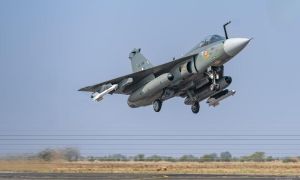
In a significant move to bolster its intelligence and surveillance operations in the Asia-Pacific region, the US Navy has deployed a second MQ-4C Triton maritime surveillance aircraft to Japan’s Kadena Air Base. This deployment, alongside numerous MQ-9 Reapers, marks an escalation in the United States’ strategic efforts to monitor Chinese naval activities. The arrival of the second Triton on June 9, 2024, underscores the growing importance of Okinawa in regional security dynamics.
An official from Japan’s Ministry of Defense confirmed the arrival of the second MQ-4C Triton at Kadena Air Base at approximately 3:40 p.m. on June 9. This deployment follows the earlier relocation of the first MQ-4C Triton from Guam to Okinawa on May 20. Images published by Japanese media show both Tritons stationed in the Navy tarmac hangar at Kadena shortly after the second aircraft’s arrival.
The US military has planned for the Tritons’ deployment to last from May to October, supported by approximately 50 personnel relocated to Kadena Air Base. This move is part of a broader strategy to enhance the surveillance capabilities of the base, which is already home to a variety of advanced aircraft and drones.
Strategic Importance of Kadena Air Base
Kadena Air Base, the largest US Air Force base in the Asia-Pacific region, holds strategic significance due to its proximity to major Asian capitals such as Beijing, Seoul, and Taipei, all within three hours of flight time. This geographical advantage makes Kadena crucial for Japan’s defense and a focal point in US military operations in the region.
Since October, the base has been undergoing a rotational deployment of various advanced fighter jets, including F-35 Lightning IIs, F-22 Raptors, US F-16s, and F-15E Strike Eagles. This rotation aims to replace the older F-15C/D fighter jets with newer and more advanced aircraft, enhancing the base’s operational readiness.
Enhanced Reconnaissance Capabilities
In addition to the MQ-4C Tritons, eight US Air Force MQ-9 Reaper drones have been stationed at Kadena since October, significantly boosting the base’s reconnaissance and surveillance capabilities. These drones play a crucial role in intelligence gathering, providing persistent surveillance over extended periods.
According to a report from the Federal Aviation Administration (FAA), the second MQ-4C Triton was scheduled to conduct a flight around Okinawa’s main island on the evening of June 9. However, this plan was withdrawn from the Notice to Airmen (NOTAM) shortly after the aircraft’s arrival.
The deployment of the Tritons and MQ-9 Reapers has not been without controversy. Local governments and the Okinawa Prefecture have voiced strong opposition to the indefinite presence of these drones. The Kadena Town Council has raised concerns about the potential for aircraft accidents due to the increasing number of US military assets at the base.
The MQ-4C Triton, developed by Northrop Grumman, is a sophisticated maritime surveillance aircraft with previous deployments to Misawa Air Base in northeastern Japan. Although it resembles the RQ-4 Global Hawk, the Triton is distinct in its capabilities and design.
The Triton features reinforced leading edges along its wings to withstand bird strikes and electronic systems designed to endure power surges from lightning strikes. Its rigid wing design allows for rapid descents to lower altitudes for close-range observation of maritime targets. Equipped with advanced sensors and surveillance technology, the Triton can deliver precise targeting information to naval assets, enhancing their ability to engage targets beyond the horizon.
With the deployment of these two advanced reconnaissance aircraft at Kadena, the US military is poised to intensify its surveillance and intelligence operations in a region where China’s activities are of increasing concern. Officials have disclosed plans for the drones to undertake intelligence missions in the Nansei region and its surrounding areas, covering crucial maritime territories.
Rising Tensions in the East and South China Seas
China has been increasingly assertive in its maritime claims in the East and South China seas, frequently intruding into waters claimed by Japan around the Senkaku Islands. Japan views these incursions as attempts by China to undermine its control over the uninhabited islands, thus casting doubts on its sovereignty.
The continuous presence of Chinese vessels near the Senkaku Islands, coupled with their prolonged stays, has heightened Japan’s concerns about its territorial claims. Drones, with their ability to provide persistent surveillance, offer a strategic advantage in monitoring these activities without being overtly provocative.
The deployment of the second MQ-4C Triton to Kadena Air Base represents a significant step in enhancing the US Navy’s surveillance capabilities in the Asia-Pacific region. As tensions with China continue to rise, the strategic use of advanced reconnaissance aircraft like the Triton and MQ-9 Reapers will play a crucial role in maintaining regional stability and security. The ongoing opposition from local governments highlights the complex dynamics of military deployments in Okinawa, balancing strategic imperatives with community concerns.






